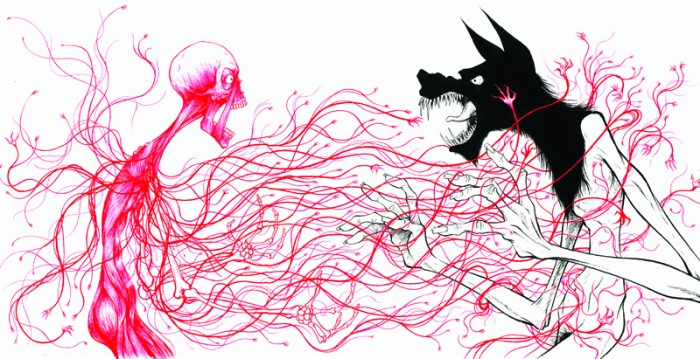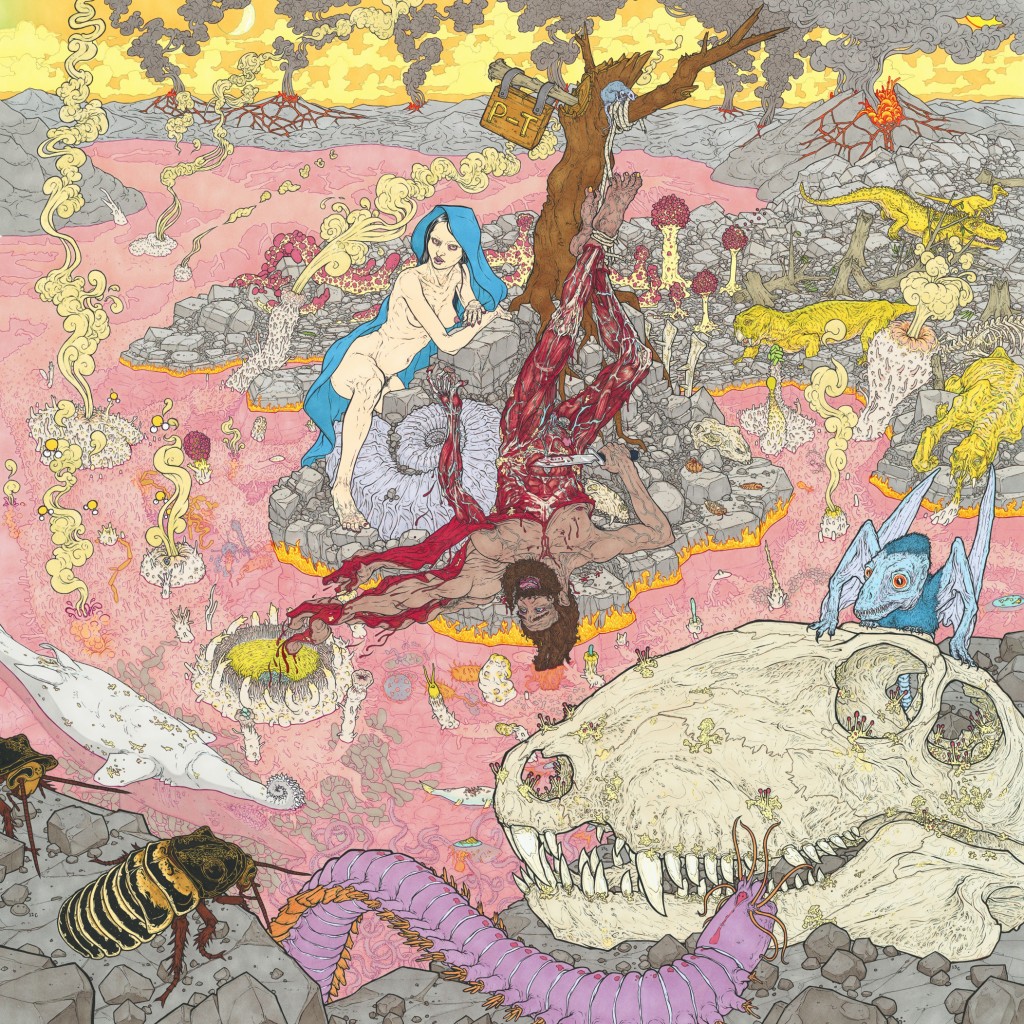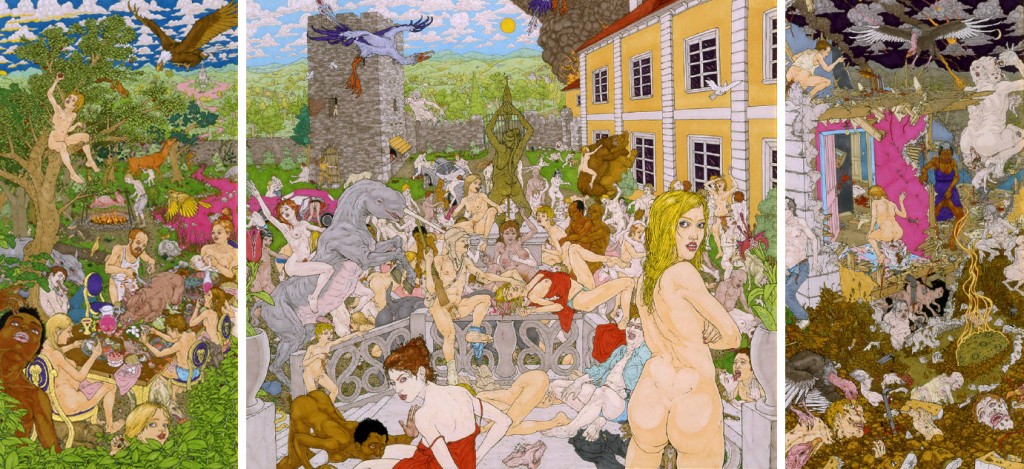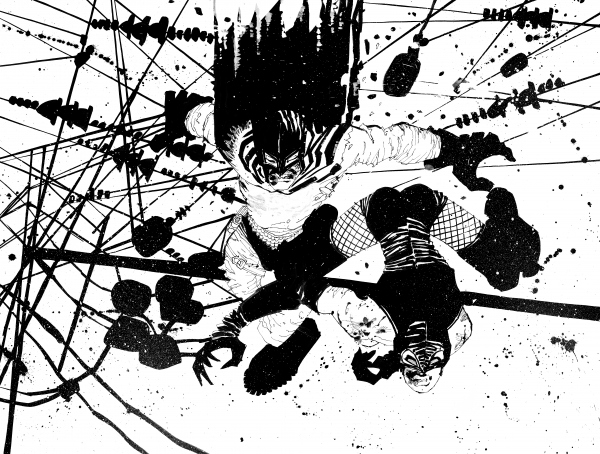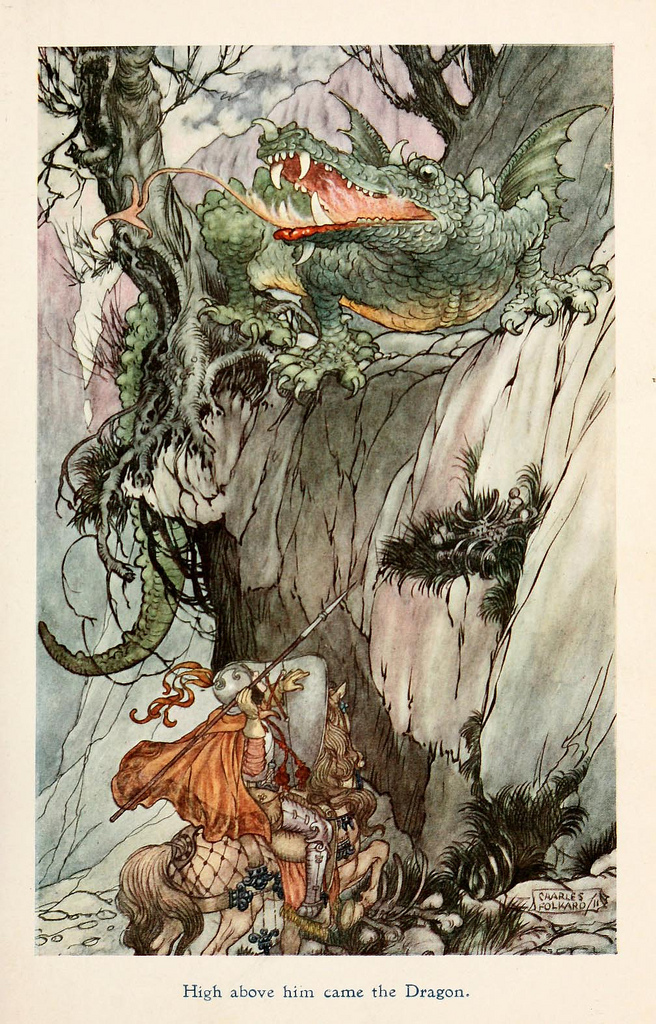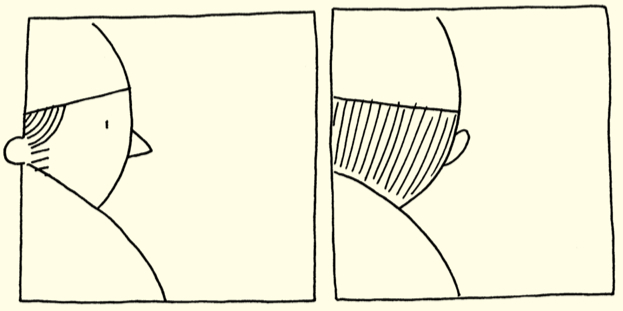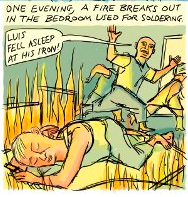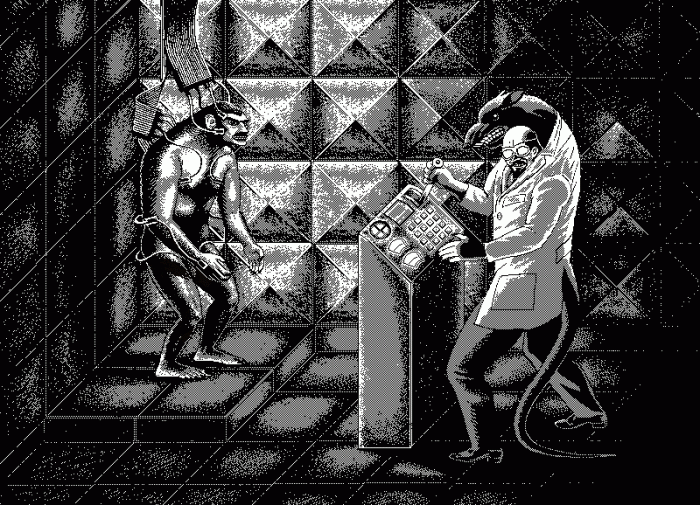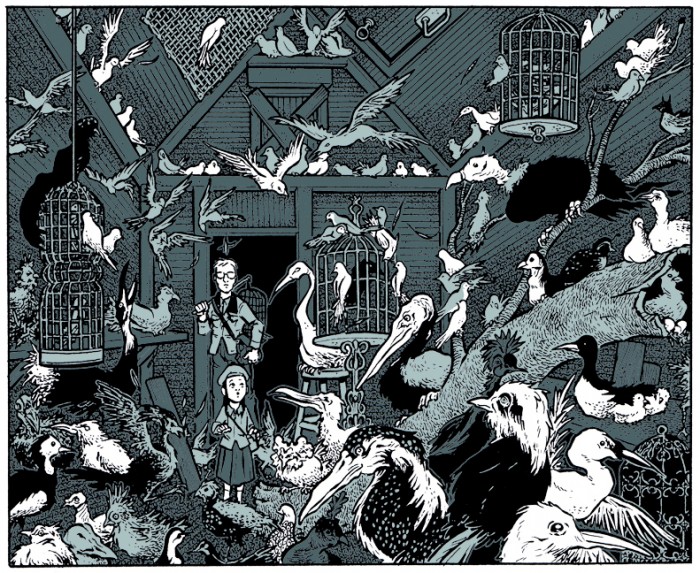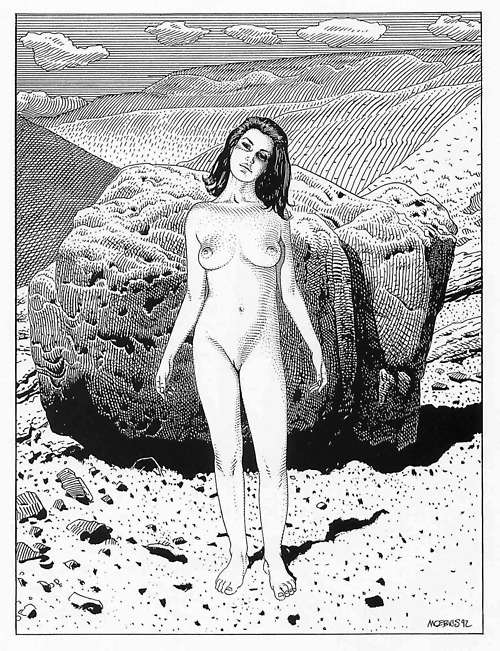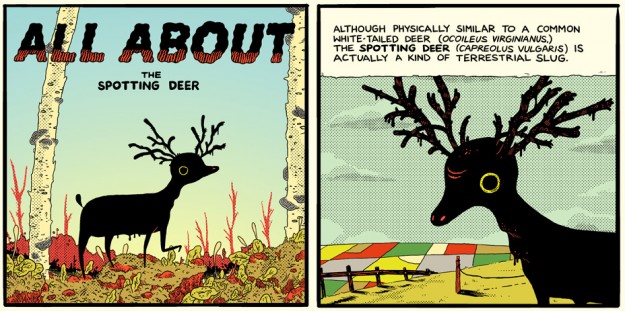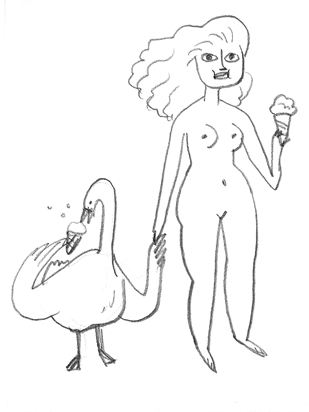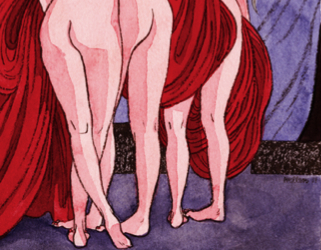Posts Tagged ‘George R.R. Martin’
Blog closed on account of dragons
July 12, 2011A brief programming note: Blogging will be very light until I finish reading A Dance with Dragons. I will not be using Twitter at all during this time, and will likely stay away from Tumblr and the bulk of the Internet as well. Thank you for your patience, and I’ll see you on the other side.
Carnival of souls: Tom Neely, Mat Brown, Dave Kiersh, Frank Miller, more
July 5, 2011* I’m very excited to direct you to my interview with Tom Neely about his new graphic novel The Wolf, which includes a selection of preview pages. The book is Tom’s best, and one of the best of the year.
* When was the last time you were truly amazed by an artist you’d just seen for the first time? For me it was my discovery via Monster Brains of Mat Brown. This stuff is incredible — like the Sistine Chapel painted by an Alien facehugger attached to Geof Darrow. Click through to see it at full size.
I mean, seriously.
* Whoa: Dave Kiersh has an entire blog dedicated to posting his early minicomics in their entirety. My favorites so far are 1998-99’s Quaaludes, 1999’s Young Adult, and 2003’s Amazons, none of which I’ve seen before despite being a fairly dedicated Dave K. fan. It’s amazing to think he hit his teenage-heartbreak sweet spot when he pretty much was a teenager.
* Mmmm, hot licks from Holy Terror by Frank Miller.
* George R.R. Martin’s A Song of Ice and Fire occupies four of the top ten New York Times paperback best sellers right now, including #1. Don’t click the list unless you want the shit spoiled out of books three and four, though.
* Is it just me, or are the Harvey Award nominees better than the Eisner Award nominees this year? Like, insofar as they actually nominated Acme Novelty Library #20 and Love & Rockets: New Stories #3?
* Gabrielle Bell will be posting a diary comic every day for the month of July. Good news for people who like to see new Bell.
* The Comics Grid’s Kathleen Dunley takes a close look at the overabundance of information in the truly horrifying torture sequence from Brian Chippendale’s Ninja. I’d forgotten how difficult that page was to take.
* I’m actually not nuts about the posts in practice — they feel a bit underbaked, a bit too dependent on the reader sharing certain assumptions about and impressions of any given song — but in theory, the music blog One Week One Band spending seven days talking about David Bowie’s 1990s work (with writer Ian McDuffie) is an exciting prospect to me, since that’s the first David Bowie I knew. Like Tori Amos, Aphex Twin, Pantera, Pink Floyd, Marilyn Manson, Gary Numan, and Joy Division, I got into David Bowie because Trent Reznor was into David Bowie. Earthling was my first Bowie record, and it’s still one of my favorites. It’s so loud!
* Better in practice is Matt Zoller Seitz’s list of The 10 Loudest Movies Ever!! It’s basically seven films that are varying degrees of wonderful and then three piles of shit.
* Uno Moralez’s random
image/gif gallery posts are really the best bang for your internet buck. Please click the link — if you haven’t seen one of these things, you can’t understand.
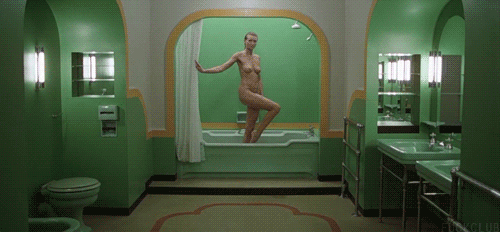
* This is almost anticlimactic after the earlier Mat Brown link, but Monster Brains’ Charles James Folkard gallery is lovely as well. Aeron Alfrey’s really been on a hot streak at that site lately.
* Tom Brevoort gives good interview.
Nostalgia is powerful and potent, and it’s one of the things, particularly for the longtime audience, that makes things go. If you can drop in a reference or do a twist or bounce some story point off a comic we fondly remember, we as an audience like it. It works for us. It rewards the investment in the material and the time spent, and it creates a larger sense of involvement than is typically possible in a single TV show or a movie or a novel. It’s one of the things that comics can do with their serial storytelling style that many other forms of entertainment can’t. The danger there is that if you rely on it too much, you’re telling stories only for people who have been reading for 30 years or who are willing to put in the hard work to understand whatever it is you’re talking about – the particular language you’re speaking. That’s the balancing act.
* It’s hard out here for a cartoonist: Theo Ellsworth edition.
* Best of luck to my old Wizard coworker Rick Marshall as he departs MTV’s Splash Page blog.
* Film and culture historian Robert Sklar has died, rather tragically. A part of me will always be a Film Studies student, and that part is very saddened by this.
Playing a Game of Thrones: Why you should read George R.R. Martin’s A Song of Ice and Fire series
June 22, 2011Regular readers of this blog are no doubt aware (to say the least!) that I am a big fan of George R.R. Martin’s series of fantasy novels called A Song of Ice and Fire, and that I’m eagerly anticipating the HBO series adapting them, called Game of Thrones. But a few days ago I realized that you might not know why. Credit for this goes to my blogging chum Curt Purcell, who used the occasion of my umpty-millionth post on the topic to ask:
Without giving too much away, can you maybe hit a few bullet-points about what sets SONG OF ICE AND FIRE apart from other similar fantasy series? It sounds so run-of-the-mill, even when people gush about it. What am I missing that would make me want to read it?
As I said in the comment I left to answer his questions, I’m such an enthusiast for this material that I don’t know if I’ll be any good at expressing or explaining why. (I’m also emotionally and physically exhausted due to all sorts of off-blog goings-on this past week and am not at my most cogent.) But I’ll take a shot at running down some of the series’ distinguishing characteristics. Sit back, relax, and enjoy the hard sell.
First off, what exactly are we talking about here? Well, as I said, A Song of Ice and Fire is a series of epic fantasy novels by writer George R.R. Martin, whom some comic fans and nerds may know from his involvement with the Wild Cards series of revisionist-superhero prose novels, or for his time on the writing staff for the Ron Perlman/Linda Hamilton Beauty and the Beast TV show. So far, four volumes of a (sort-of^) planned seven have been released: A Game of Thrones, A Clash of Kings, A Storm of Swords, and A Feast for Crows. The HBO series, spearheaded by David Benioff and Dan Weiss, takes its title (sans indefinite article) from the first volume and will debut on April 17; the plan is to adapt one book per season, although the books get so long that some may need to be spread over the course of two seasons.
What’s the setting? Without spoiling anything important, here goes: The books take place mostly in a land called Westeros, your basic roughly medieval-European epic fantasy setting, albeit one with far, far fewer overt trappings of fantasy than, say The Lord of the Rings — humans are the only game in town in terms of races, and we’re several generations removed from the last time magic/sorcery or mythical creatures like dragons were a going concern. The main fantastical feature when the story begins is how the flow of seasons work: Summer and winter can each last for years, decades even, before shifting unpredictably.
Westeros, which ranges from an arctic climate up north to a Mediterranean one down south and has similar cultural lines of demarcation, was once divided up into Seven Kingdoms, each ruled by great families, or Houses. But for centuries now, the whole continent has been united under one ruling King. However, about 15 years or so before the story begins, a group of powerful Houses banded together to overthrow the current king, who had gone insane, thus ending the kingdom’s first and up until that point only dynasty.
What’s the story about? Again, without spoiling anything important: It’s 15 years after Mad King Aerys of House Targaryen was overthrown by an alliance of nobles who were either burned by his cruelty or hungry for power of their own, or some combination thereof. The leader of the alliance, Robert Baratheon, has been king ever since, supported by his wife’s hugely influential, hugely assholish family, House Lannister. But when his mentor and right-hand man dies (or is murdered — no one’s really sure), Robert, who seems well-intentioned but by now is kind of a drunk and glutton and horndog and not a very good king, heads north to seek the help of his best friend, Eddard Stark, who has command of the kingdom’s distinctly unglamorous northernmost area. A Game of Thrones primarily chronicles the conflicts between House Stark and House Lannister as Ned, as he’s known to his friends, tries to help out King Robert and get to the bottom of the mystery of their mutual mentor’s death, and some other shady goings-on as well.
But meanwhile, two threats are brewing beyond the kingdom’s borders and outside the struggle for power and influence surrounding the rival Houses. The first lies in the uncivilized wastelands to the North, beyond a massive Great Wall of China-type structure called The Wall, a 700-foot-tall barrier made totally of ice that stretches from sea to sea. Thousands of years ago some kind of supernatural menace came out of the North to threaten the Seven Kingdoms, and the Wall was constructed after mankind’s victory to keep the threat from coming back. By now it’s been so long that the organization tasked with maintaining the wall is a neglected, ragtag band, ill-prepared for…whatever it is that seems to be going on out there, somewhere.
The other lies overseas, where the only two survivors of the overthrow of House Targaryen, a boy named Viserys and a girl named Danaerys, have hit their teenage years and are trying to mount a comeback. Even though Aerys was a major creep, and Viserys is no great shakes either, if the two of them get the right backers and the right soldiers, they could present a major threat to the new rulers of their old kingdom, who know they’re out there but have no idea how to find them.
Why should I care about any of this? This is really the heart of Curt’s question, and probably yours, if you have a question about the series yourself. Chances are you either are perfectly conversant and comfortable with the standard tropes of fantasy and thus this series’ specific iterations thereof aren’t enough to hook you, or you’re the sort of person who automatically tunes out anytime someone in a tunic whips out a sword and says “I am Aragorn son of Arathorn, heir to the throne of Gondor” or somesuch and thus you’re skeptical that the books would be for you even if they’re the best gosh-darn stories about a made-up kingdom of knights and dragons and shit ever invented. With all of you in mind, I put together a list of what sets the books apart, both for me and, from what I’ve gathered based on talking to and reading about other fans, for a lot of people. This is the stuff that matters.
1) I mentioned this already, but it bears repeating: The fantasy elements are surprisingly minimal, particularly at first. Simply put, if you’re the kind of person who can’t stand elves and orcs and dwarves and wise old wizards, they won’t be around to turn you off out of hand. Now, this wasn’t really a selling point for me, since I’m a person who has the White Tree of Gondor tattooed on my left arm and obviously has no preexisting, in-principle problem with elves and orcs and dwarves and things of that nature. But I think you’d be surprised at how little high/epic fantasy I’ve actually read outside of The Lord of the Rings. The vast majority of my fantasy reading was done when I was a YA reader, and was centered either on satires (Piers Anthony’s Xanth books, Robert Asprin’s Myth series) or sort of off-model, less Tolkienian series (this is the stuff I remember more fondly — Susan Cooper’s The Dark Is Rising Sequence, Ursula K. LeGuin’s Earthsea trilogy, and Lloyd Alexander’s Prydain Chronicles, the most Tolkienian of the group but still pretty far removed from the Elves/Dwarves/Orcs model that dominates much of the genre)). In my mind, I’d come to associate stuff that more directly bore the fingerprints of Professor T or his Gygaxian reinterpreters with either unoriginality, tedium, or cheese. So a series that focused more on character and worldbuilding in the cultural and historical senses of that word than on invented races or bestiaries or magical systems was perfect for me when deciding to give fantasy another try at age thirtysomething.
2) A closely related point: In the absence of magical stuff, the story’s driven by realistic human conflicts. Martin has said that the series’ central struggle for power — the titular game of thrones played by various important people we meet — was inspired by England’s real-world War of the Roses, with its complex web of family loyalties and regional rivalries and so on. In terms of narrative fiction, I think the the closest comparison is The Godfather and The Godfather Part II. A Game of Thrones combines the first film’s story of rival families violently jockeying for supremacy amid all sorts of complex conspiracies and alliances with the second film’s story of the very serious, very smart leader of one of those families trying to uncover the origin of a plot against him and his. The point is that we’re very far from rote Joseph Campbell hero’s-journey fantasy storytelling, with some dude learning it’s his destiny to defeat the Dark Lord. If you’re sick of that sort of thing, you’ll find a lot more to hook you here. This goes double if you’re the sort of person who’s ever enjoyed fictional or non-fictional war epics or gangster stories. “The Sopranos with swords” really is a pretty dead-on way to describe what’s going on here.
3) Another reason “The Sopranos with swords” works, and probably one of the big reasons HBO bit: There’s graphic language, violence, and sex. Again, I’m not particularly well-read in the genre, but this is something I’ve really never seen before, not outside weirdo projects like CF’s Powr Mastrs — and this isn’t some cult-favorite alternative comic series, it’s the most popular and influential contemporary fantasy series other than Robert Jordan’s Wheel of Time. If you’re the sort of person who’s complained that Tolkien’s world is too sexless and bloodless to really care about, believe me, you won’t be voicing similar complaints here. I’ll elaborate on this a bit below, but I also would argue strongly against the notion that any of this is shock for shock’s sake, or rote revisionism. It’s simply Martin writing fantasy the way other writers would write about any other world full of human beings who kill each other and have sex and get pissed off. It’s refreshing. “Deadwood with swords” works here.
4) One last related point: The story isn’t just set in a (relatively) realistic world, driven by realistic human conflicts, and featuring realistic human behavior — it’s powered by relatable human relationships, emotions, drives, desires, and even mistakes. I’ve written about this at length before in somewhat spoilery fashion, but to recap it here, so much of what happens in these books hinges on the personal relationships between the characters, and the way old grudges or old friendships cloud judgment and lead to poor decisions. Perfectly well-intentioned, innately noble characters can’t stand other perfectly well-intentioned, innately noble characters for various reasons that are all too familiar — long-ago affairs, half-forgotten insults, petty jealousies. Characters will know full well that their family is a collection of really awful people, but they’ll still do their level best to help out because hey, it’s family, and it’s psychologically and emotionally tough as hell to leave your family behind. In other words, like all of the best HBO shows did with their respective genres — The Sopranos with the mafia, Deadwood with Westerns, The Wire with cop shows — A Song of Ice and Fire isn’t just surface revisionism, it’s bringing the full weight of richness of literary fiction to genre entertainment.
5) Moving on, here’s a point about the basic logistics of reading these books: The structure of the narrative is highly addictive. Each chapter focuses on a particular character, whose name serves as that chapter’s title, and the characters rotate throughout the book(s). This has the effect of embroiling you in a particular character’s situation or storyline, then immediately popping you over into another’s, so that you find yourself racing through the chapters to get to the next one starring the person you’re interested in — and then getting interested in the ones you’re reading in the interim, and repeating the process over and over. It’s rather brilliant.
6) The raw plot is enormously engrossing. There’s a dynastic struggle that encompasses a murder mystery, a conspiracy, shifting and secret alliances, political machinations — and then brewing underneath it all, two major external threats. You find yourself wanting almost desperately to get to the bottom of it all, and Martin is a strong enough writer to keep adding elements without drowning out the ones that hooked you in the first place. A good comparison here might be Lost, where each time you hit the ground level of the until-then central strain of antagonism, the creators yanked the rug out and revealed another beneath it. The shape and scope of the story is perpetually enriching and expanding.
7) I think Martin’s a pretty strong prose craftsman. There are a few groaners in there, especially in the first book (I think there are two warm fires in the hearth that couldn’t chase away the coldness in Character X and Y’s hearts, for example), but let’s just say that my dayjob sees a lot of SF/F pass across my desk and some of it is embarrassingly badly written. Martin knows his way around the typewriter.
8.) Big surprises, as shocking and powerful as any I’ve read or seen in any work of narrative fiction ever. Stuff that’s on the level of all-time gut-punches like “I did it thirty-five minutes ago” or “You are the dead” (or for you altcomix readers, the big moments in ACME Novelty Library #20 or Love & Rockets: New Stories #3). You want to stay as spoiler-free as possible about these books, that’s all I’ll say. Like, if you start reading them, don’t even read the back-cover or inside-flap blurbs. (Seriously, DON’T.) This is not to say that if you know the surprises, you won’t enjoy the books — I knew one of ‘em and still loved it, just like I knew all of the major deaths in The Sopranos through Season Four and still loved it — but man oh man. There’s one part that had me so stunned and upset I literally lost sleep over it, and sat there rereading the chapter, sure I must have missed something or somehow gotten what I’d read wrong. I didn’t. It was awesome.
9) This is hard to articulate without spoiling the grand arcs of the narrative, but suffice it to say that having read all four currently existing volumes, Martin is playing an impressively long game. I don’t want to say too much more, but when you’ve read enough to start getting a sense of where it may head in the final three volumes, it’s kind of stunning in scope. Seeds planted in the first volume are carefully cultivated and tended to for multiple books and multiple years and multiple thousands of pages and still haven’t blossomed yet. Best of all, I think this all ties to one of the central themes of the series, but again, I don’t want to spoil anything.
10) This one’s important: There’s basically nothing glorious or badass whatsoever about violence as portrayed in these books. Most great fantasies don’t skimp on the emotional consequences of being enmeshed in these great struggles — the scouring of the Shire and Frodo’s departure are obviously the beating heart of The Lord of the Rings just for starters — but I don’t think I’ve ever read a heroic fiction that so relentlessly drives home how war and violence immiserate and degrade everyone who participates in them. There’s a haunting flashback in the first volume that in other hands would have been a depiction of some great and glorious last stand, but Martin imbues it so thoroughly with a sense of great sadness and loss and waste and terror. It’s beautiful and really humanistic. Now, I know Tom Spurgeon, who’s no dummy, disagrees with me on how the violence in the book comes across — he thinks it’s Mark Millar’s Ultimate Lord of the Rings, not because he feels Martin is glib or crass or glorifying the violence, mind you, but simply because he feels the use of violence is primarily calculated to get the material over with maximum genre-tweaking impact — but as he’ll also tell you, he’s in a very small minority on this. Martin, as it turns out, was a conscientious objector during the Vietnam War; I know that doesn’t necessarily reveal a fundamental truth about him beyond “he really didn’t want to go to Vietnam,” but in reading these books, I think his draft board made the right call.
11) That said, when there is action and violence, it’s really strong and really heart-pounding. And when there is fantasy, it’s exciting and strange and awesome, in the original sense of the word. The reason why is the same in both cases: We know that in this world, both swordplay and the supernatural have irrevocable, terrible, life-changing, world-altering consequences.
In short (haha, yeah right), I’m about to say something that I pretty much never say, even about works I deeply love and even to readers whose tastes I feel I understand deeply: I recommend these books without hesitation or qualification. And I’ve done so to readers ranging from my Destructor compadre Matt Wiegle to the fiftysomething mother of two grown children who works in the cubicle next to me, all of whom are basically over the moon for them. If you look into ASoIaF fandom at all, you’ll find this story repeated over and over: Fantasy skeptic gets enthusiastic recommendation from trusted friend, says “What the hell, I’ll give it fifty pages,” and within hours is passing on enthusiastic recommendations of their own. Consider this mine.
^ Why the “sort of”? The series was originally envisioned as a trilogy, but it grew to four volumes and then to six as Martin wrote the initial volumes. When he hit the writing process for the fourth book, he realized the amount of material he wanted to cover would require the book to be split in half even just as a logistical matter, so the series is now slated seven books long. This decision, plus his decision to scrap a planned “five-year jump” for the story between volumes three and four and his subsequent need to re-write and re-conceive a lot of existing work, led to a lengthy delay between A Storm of Swords and A Feast for Crows and a positively infamous delay between Crows and the planned fifth volume, A Dance with Dragons. Martin seemed to have planned to announce a publication date for Dragons during the TCA press tour last week, but an illness around Christmastime sideswiped him; still, I expect an announcement on the book before or when the HBO series debuts in April.
Carnival of souls: Brian Chippendale on Marvel, Kim Thompson on Tardi/Manchette, the Big Man, more
June 20, 2011* My final Game of Thrones chat with Megan Morse is now up at The Cool Kids Table. I’d say this one’s most interesting for our talk of different approaches to season finales, and what was expected here versus what was delivered.
* Brian Chippendale is back writing about Marvel comics! Nobody does it better. He’s absolutely right that Uncanny X-Force is a really good book, by the way. Also, Brian Chippendale is on Twitter.
* Kim Thompson interviews himself about the new Jacques Tardi/Jean-Patrick Manchette book Like a Sniper Lining Up His Shot. I really don’t like the sound of what he says about cat lovers beware.
* Over at Topless Robot, my pal Rob Bricken has some fun at Green Lantern‘s expense. As he and I have both said before, you can put up with almost any number of plot holes of whatever width provided the stuff those holes were poked in was worthwhile to begin with.
* John Porcellino’s King-Cat #69 is now up on What Things Do. I liked that issue.
* New Ben Katchor is always a delight.
* Uno Moralez is great update: Uno Moralez is great.
* I haven’t been following Hans Rickheit’s Ectopiary; this page tells me I ought to get on that toot sweet.
* And how about that Moebius?
* Finally, I will miss Clarence Clemons, who helped make this.
Game of Thrones thoughts index
June 20, 2011Here are links to all of my Game of Thrones reviews. I’ve added the special features I’ve written for Rolling Stone to the list chronologically, so that once you’ve read the preceding review post, it’s safe to read that feature as well. I hope you enjoy them!
SEASON ONE
Episode 01: Winter Is Coming
Episode 02: The Kingsroad
Episode 03: Lord Snow
Episode 04: Cripples, Bastards, and Broken Things
Episode 05: The Wolf and the Lion
Episode 06: A Golden Crown
Episode 07: You Win or You Die
Episode 08: The Pointy End
Episode 09: Baelor
Episode 10: Fire and Blood
List: The Seven Most Awful Things People Did on Game of Thrones Season One
SEASON TWO
Episode 11: The North Remembers
Episode 12: The Night Lands
Episode 13: What Is Dead May Never Die
Episode 14: Garden of Bones
Episode 15: The Ghost of Harrenhal
Episode 16: The Old Gods and the New
Episode 17: A Man Without Honor
List: The 10 Biggest Differences Between Game of Thrones and the Books
Episode 18: The Prince of Winterfell
Episode 19: Blackwater
Episode 20: Valar Morghulis
* Follow-up 01
* Follow-up 02
List: The Best and Worst New Characters in Game of Thrones Season Two
List: Final Standings in the Game of Thrones After Season Two
SEASON THREE
Q&A: Bryan Cogman (Executive Story Editor)
Season Three Cheat Sheet
Season Three New Character Guide
Episode 21: “Valar Dohaeris”
Q&A: Natalie Dormer (Margaery Tyrell)
Episode 22: “Dark Wings, Dark Words”
Q&A: Sophie Turner (Sansa Stark)
Episode 23: “Walk of Punishment”
Q&A: Nikolaj Coster-Waldau (Jaime Lannister)
Episode 24: “And Now His Watch Is Ended”
Q&A: Alfie Allen (Theon Greyjoy)
Episode 25: “Kissed by Fire”
Q&A: Maisie Williams (Arya Stark)
Episode 26: “The Climb”
Q&A: Aiden Gillen (Petyr “Littlefinger” Baelish)
Episode 27: “The Bear and the Maiden Fair”
Episode 28: “Second Sons”
Q&A: Gwendoline Christie (Brienne of Tarth)
Episode 29: “The Rains of Castamere”
Q&A: Richard Madden (Robb Stark)
Taking stock of Season Three: Bloggingheads.tv discussion with Alyssa Rosenberg
Episode 30: “Mhysa”
SEASON FOUR
The Top 40 Game of Thrones Characters, Ranked
Season Four Cheat Sheet
Q&A: Pedro Pascal (Prince Oberyn Martell)
Episode 31: “Two Swords”
Q&A: Rory McCann (Sandor Clegane/The Hound)
Episode 32: “The Lion and the Rose”
Episode 33: “Breaker of Chains”
Episode 33 extra: on “that scene”
Q&A: Aiden Gillen (Petyr Baelish/Littlefinger)
Episode 34: “Oathkeeper”
Episode 34 extra: more on “that scene” and its aftermath
Episode 35: “The First of His Name”
Episode 36: “The Laws of Gods and Men”
Episode 37: “Mockingbird”
Episode 38: “The Mountain and the Viper”
Episode 39: “The Watchers on the Wall”
Q&A: Neil Marshall (director, “The Watchers on the Wall,” “Blackwater”)
Episode 40: “The Children”
The Top 10 Greatest Moments from Game of Thrones Season Four
Carnival of souls: Retrofit, Matt Zoller Seitz on Game of Thrones, Tom Brevoort on pitching, more
June 17, 2011* Box Brown is starting a Kickstarter-funded line of pamphlet-format alternative comic books called Retrofit, by an array of names you’ll recognize. I increasingly feel that the real competition for this sort of work isn’t graphic novels but the Internet, but either way, it’s a worthwhile endeavor.
* Matt Zoller Seitz proclaims Game of Thrones Season One one of the best first seasons of television of all time. As a fanboy of both entities, I was almost inappropriately delighted to read this. I think Seitz is likely right that the show will improve on repeat viewing once you’ve seen the whole run so far.
* I think that if you’ve read interviews with comparable figures from the superhero comics industry, you may have a better sense of why I appreciate Tom Brevoort’s interviews as much as I do. This one focuses on how Marvel goes about crafting new series: whether they stem from a niche that needs filling or an idea that grows organically, whether they’re generated from within by editorial, from outside by a writer with a pitch, or from some combination thereof.
* If you ever wanted to read Michael DeForge’s excellent comic Spotting Deer online for free, well, now you can.
* Kristy Valenti reviews Jess Fink’s sexy sex comic Chester 5000 XYV, which in addition to being fun was a comic I found surprisingly provocative in an unexpected way.
* Hey, Kate Beaton works blue!
* Speaking of naked lady drawings, I assure you you want to click through and see this entire Hellen Jo illustration. She’s a talent.
* The cover for Esperanza, the latest Jaime Hernandez Love and Rockets digest, is one of the series’ most appealing so far.
* Go buy some original art from Paul Pope! I’ll wait.
* The Beast of Busco has long been once of my favorite cryptids.
Sellsword update
June 15, 2011I contributed an essay recommending A Song of Ice and Fire for the latest issue of The Lifted Brow, the fine Australian arts magazine. To put on my other nerd hat for a moment, there’s also comics and art from the likes of Blaise Larmee, Lane Milburn, Noel Freibert, Lisa Hanwalt, and Eddie Campbell. You should check it out.
Also, my weekly Game of Thrones chat with Megan Morse is up at The Cool Kids Table. This one ends on a high note.
Game of Thrones thoughts: Season One, Episode Nine – NON-SPOILERY EDITION
June 13, 2011SPOILERS FOR THE SHOW, NO SPOILERS FOR THE BOOKS – if you haven’t read the books, you can still read this . Crossposted from the spoilery edition at All Leather Must Be Boiled.
* That was tough to watch. Who knew? Maybe months of anticipating what would happen in this episode were enough to recreate a week of wondering what would happen in this episode. By that final scene my pulse was racing, and I had that elevator-dropped-out feeling in my stomach I’d grown familiar with from The Sopranos, Deadwood, The Wire, Battlestar Galactica, and Lost, shows that at one point or another had me convinced that anyone, literally anyone, might not make it to the end of a given episode. Only this time, I knew, and still got that feeling.
* It was the show’s best scene as filmmaking, certainly. Sweeping camera movements to create a sense of immersion and environment, intelligent sound design that highlighted or dropped this or that element to hyperfocus our attention, terrific performances from Sophie Turner and Maisie Williams and Sean Bean. Even little details, like how Joffrey was framed when he ordered the execution, or the way Ser Ilyn Payne just materialized out of nowhere, slapped on his mask, and brought the sword down, delivered.
* You’re primed to think the big question is “Will Ned sacrifice his honor or die?”, not “Will Ned sacrifice his honor and die?” The misdirection goes well beyond “they’ll never kill the main character…will they?” and into how the whole back half of the season/book is constructed.
* Jeez, the Hound is huge. Did you see him holding Ned on the steps when Ned got beaned by the crowd? He towered over Sean Bean.
* And speaking of sound design, the sounds from Drogo’s tent…woof, that was good stuff. I actually think this was a more frightening way to approach it than the scary shadows of the book. It’s actually more of a challenge to make a tent feel like a mouth into hell in broad daylight, but those horrible bellows and screams were more than enough. I wouldn’t have gone in there.
* I’m glad to see Varys’s motives being revealed and treated as sincere. Even Ned seems to get that. Conleth Hill was especially good in that scene, every bit the practiced liar finally letting his guard down and delivering some real talk.
* Michelle Fairley continues to improve as Catelyn. Her anger and frustration with Walder Frey’s pettiness and her tears of joy upon seeing Robb return from battle were her two most human displays in the whole series. Catelyn’s our main character now, for all intents and purposes, and this episode made me a lot more optimistic about that prospect.
* Tyrion’s sleepover party with Bronn and Shae was a blast. You’ve got to hand it to Jerome Flynn and Sibel Kikelli, who took two characters we barely know, including one we just met, sat them alongside a main character played by a beloved actor, and made it feel like yeah, absolutely these three people would stay up into the wee hours drinking and goofing around together. I’m a softie, so I’m happy anytime characters in fiction about how hard the world is manage to respect and befriend one another.
* Just a lot of fine moments sprinkled throughout the whole episode, actually. Sticking Tyrion on the dolly for that shot as he comes to was inspired, just as discombobulating as you’d imagine it was for Tyrion. Maester Aemon comes out of nowhere to reveal that he’s one of the most important people in the world. Jon’s fellow grunts flip out over his sword like the teenage boys they are, while Rast and his fellow raper sit in the corner glowering. It was a really, really good hour of television, good enough to get me too keyed up to sleep properly.
* I’ve long said it’s a mug’s game for people like me to try to speak for viewers who’ve never read the books, but I do wonder what they made of this episode’s two major battles taking place off-screen. Since I’ve been following the production of the show from day one, I was aware that budget limitations constrained them from going too crazy in the battle department, but I did expect that they’d get at least one in before the season was over, and it stood to reason that Tyrion riding into battle at the front of a horde of screaming tribesmen was going to be the one. Instead he got clocked on the head and slept through the battle. While this was certainly true to the material’s penchant for puncturing the glory balloon and letting all the air seep out, it also felt like what it was — a way to save money. Ditto Robb’s victory in the Whispering Wood, despite it being presented in much the same off-screen way it was in the book. Since the show isn’t wedded to the book’s POV-character structure, it’s show itself to be perfectly capable of showing us what was going on when our POVs were elsewhere. Robb Stark’s direwolf-aided sneak attack on Jaime Lannister would be a logical choice in that regard, you’d think. It’s a testament to the filmmakers that this episode felt as epic and portentous as it did even though both battles were presented as a fait accompli.
* And boy, there’s nothing quite like feeling disappointed about the lack of battle scenes to make you question if you’ve truly internalized A Song of Ice and Fire’s anti-war message as much as you’d thought. I think I’m okay with my desire to see a good battle scene despite my growing (and ASoIaF-aided!) pacifism — after all, it is okay to enjoy things in art you’d never enjoy in real life. Certainly someone as apt to freak out over animal cruelty as I am had to come to grips with that fact if I were to watch the show at all. But more than that — and here I credit Maureen Ryan, who’s been something of a killjoy about the show, for the insight — A Song of Ice and Fire is a series about war, and it’s tough to be about war without showing war. I still think the message gets through thanks to all the other horrible killings we’ve seen, but seasons down the line, things like Septon Meribald’s monologue about broken men are going to have less of an impact if we’ve never seen why men might break. Or maybe I just want some exciting and thrilling carnage. Maybe it’s both.
Carnival of souls: DC, DeForge, alternative comics Tumblrs, more
June 6, 2011* DC’s line-wide relaunch/day-and-date digital push has dominated industry news since its announcement last week. A few links of note:
* The line will get a new flagship title in the form of Geoff Johns and Jim Lee’s Justice League. That should sell like gangbusters.
* DC’s mostly taking an “if it ain’t broke, don’t fix it” approach to its two most successful franchises: The creative teams behind both the Green Lantern and Batman lines stay more or less the same, though several of them trade titles.
* Marvel’s Tom Brevoort emerged as one of the move’s most persistent and persuasive defenders — I mean, he’s not cheerleading the thing, but he’s not lambasting it or laughing it off, and is defending it against some fans who are doing so. One caveat: He said this stuff before the creative-team announcements started rolling out.
* Some of the better reaction/analysis pieces I’ve seen: Tim Hodler, Tom Spurgeon.
* Finally, Kiel Phegley rounds up retailer reaction; any such piece that includes such divers hands as Floating World’s Jason Leivian, DCBService.com’s Cameron Merkler, and Midtown Comics’ Gerry Gladston is well worth your time.
* If you’ve been wondering how Michael DeForge manages to be so prolific, his first entry in the Comics Journal’s Cartoonist’s Diary column has your answer: 16-hour workdays. And if you’ve been worried, here’s how he’s been keeping busy lately.
* He’s also got a strip of his usual excellence called “Teen Wolf” up at What Things Do. It’s almost like a riff on Dave Kiersh.
* Bow before the might and majesty of Gary Groth’s interview with Joe Sacco for The Comics Journal #301.
* Dan Nadel talks about differing approaches to reprinting old comics. If you’re familiar with Dan’s approach you’ll know what side he comes down on, but he’s quite fair with and accepting of several different styles, and notes the difference between reprinting comics and reprinting comics art.
* The Comics Grid’s Esther Claudio takes a look at a page from Craig Thompson’s Good-bye, Chunky Rice; the Comics Grid’s customary high-quality close reading ensues. I’m certainly stealing the phrase mise en page.
* I used some new Spider-Man comics as an excuse to link to every single superhero comic Kate Beaton has done. I think the Kraven piece for Strange Tales 2 is the best of the bunch.
* This is one of Kevin Huizenga’s better Fight or Run strips.
* This Moebius drawing is like the Rosetta stone for Uno Moralez. Via Shit Comics, an inspiring altcomix tumblr.
* Speaking of inspiring altcomix tumblrs, I spotted this image from Panayiotis Terzis’ new book Time Tunnels at Same Hat!
* Wow, Ron Regé Jr. sure can draw cats! All of his commissions look well worth the cash, actually.
* Always glad to see new comics from my friend and collaborator Isaac Moylan.
* I fully support Jillian Crowther’s concept of “pinball music”: shiny, slightly overcooked rock pop circa 1979-1981, a la “Ah! Leah.” It reminds me of my own personal place-based subgenres, centered on my memories of the defunct Long Island roller rink Laces (freestyle, electro) and the heterosexual side of Delaware’s Rehoboth Beach (Steve Perry, things that sound like “Edge of Glory” by Lady Gaga, which of course would also work on the gay side of Rehoboth Beach).
* George R.R. Martin certainly keeps busy. I can’t imagine his detractors will be super happy about the order of items on his to-do list.
* I’m extremely happy my “Happiness Is a Focused Totality of My Psychic Powers” gag made it into the latest Marvel Super Heroes What The–?! video, featuring Professor X and Magneto’s madcap ’60s adventures.
* This supercut of the 100 Greatest Movie Threats is hilarious, not gonna lie to you. Still, I’m disappointed it doesn’t include “Let her go, or I’ll fill your guts so full of lead you’ll be using your dick for a pencil” from The Three Amigos or the bit from Casino where Nicky Santoro explains to the banker what it is he does. (Via Ed Gonzalez.)
Game of Thrones thoughts: Season One, Episode Eight – NON-SPOILERY EDITION
June 6, 2011SPOILERS FOR THE SHOW, NO SPOILERS FOR THE BOOKS – If you haven’t read the books, you can still read this. Crossposted from the spoilery edition at All Leather Must Be Boiled.
* Goodness, but George R.R. Martin sure carved himself a big slice of cake by choosing (?) to handle this episode! He said on his blog that the material with Tyrion and Bronn and Shagga early on was a holdover from a previous episode written by the showrunners that was moved here during editing, but that aside, he still had to handle the massacre of all the Winterfell staff in King’s Landing; Syrio’s standoff and Arya’s escape; Sansa’s capture and attempts to ingratiate herself with/blackmail by the Lannisters; Barristan’s firing; the Dothraki raid on the Lamb People, Dany’s defense of their women, Drogo’s wounding, and the introduction of Mirri Maz Duur; Jon’s insubordination against Thorne, the wight attack, burning his hand while saving the Lord Commander, finding out about Robert and Ned; Tyrion’s arrival at Camp Lannister with the tribesmen and their subsequent arrangement with Tywin; the scenes with Varys and Ned; Catelyn’s rejection by Lysa; some Bran business; and Robb’s entire march to war. That is a lot of ground to cover. I don’t really wanna use the word seamless, but, well, there you have it.
* The bloody business at the beginning was quite effectively staged. After the on-screen gore of the initial sneak attack on unarmed Northmen by the Lannister goons, the rest is all implied, which somehow makes it even worse by making the viewer complicit with the deaths we don’t see — since we don’t see them, only infer them, we’re the ones cutting the throats of Syrio Forel and Septa Mordane. And the scene in which Arya flees from Syrio’s standoff only to stop short as she hears the screams and sees the shadows of the combat raging what had been her home that very morning was somehow the most brutal bit of all. You can’t go home again.
* Good for the show for giving Septa Mordane a moment of bravery. In the book she’s just a foolish old woman with a bug up her ass — you imagine this coming to her as a total shock to her conception of proper behavior, an affront to her sensibilities. Here she seems like someone who knows how the world works, knows what’s happening and what’s about to happen, and faces it anyway. I like this Septa Mordane better!
* I didn’t see this coming: The Stark daughters’ most unpleasant actions during the downfall of their father were both significantly altered. Arya’s killing of the stableboy was changed from a clumsy but still deliberate act to an accident, and Sansa didn’t narc on her father’s plans to send her back to Winterfell. I actually don’t think I have a problem with either of these. In Arya’s case, for both her and the stableboy I think the outcome is pretty much the same. In Sansa’s, I think the audience would have had a really, really hard time not just forgiving her, but even watching her scenes from then on out. (I worried about that before the show premiered.) But moreover, I couldn’t figure out how the timing would have worked out. The way it’s all conveyed in the show, it seems clear that Cersei springs into action the moment Ned tells her he knows about her and Jaime and warns her to leave before Robert returns. Sansa’s snitching would have been not just unnecessary but confusing unless the show took time it probably didn’t have to explain the precise timing. Heck, I just read through the relevant chapters and even in the book I can’t quite understand why the Lannisters saw Sansa spilling the beans as the just-in-the-nick-of-time intervention that saved their collective bacon, what with Ned going directly to Cersei and Littlefinger’s susbequent doublecross.
* Zombies need a pop-cultural season of rest worse than any other monster, so kudos to the show for figuring out a way to still make one unpleasant and uncanny and dangerous. I’m glad he was fast, and I’m glad that he moved a bit like an automaton, a terminator. Jon’s lamp toss was well-played as well.
* You’re going to lose some of the visual impact of the younger characters by aging them up, and that’s certainly true of Robb, who seems young but not a high-school sophomore suddenly placed in charge of a war. But his physical appearance still manages to work in his favor, with actor Richard Madden’s big brown eyes constantly widened with emotion — fear, anger, uncertainty, grief, whatever. He looks like someone who’s new to all this, doing his best but still very very new to it.
* Greatjon’s fingers — great stuff. That was the “What do you mean I’m funny?” of Game of Thrones.
* Every once in a while, the Monty Python-ness of it all hits me in an amusing way. The Greatjon sounds like one of John Cleese’s broader accents, while Shagga looks like Tim the Enchanter. And obviously, the Holy Grail rule of being able to tell who the King is because “he’s the only one who hasn’t got shit all over him” is very much in effect.
* It’s unfortunate that we haven’t seen enough of the Westerosi way of war yet to realize that the depredations of the Dothraki aren’t a mark of their intrinsic savagery, but a mark of everyone’s intrinsic savagery. Generally speaking, that’s a problem the show is going to have throughout due to its decision to sort of half-ass its depiction of Dothraki culture relative to Westerosi culture. These kids of comparisons are just gonna be harder to make when one of the two cultures being compared is more sketched than drawn.
* Michelle Fairley as Catelyn….aaallllllmost won me over in this episode. It had to be her turn for the hardass that did it, I guess. The performance is still too one-note and Catelyn’s still too mother-hen, but being a mother hen by urging your chicks to launch themselves at bigger meaner birds is finally the complicating character trait that TV-Catelyn needed.
* I didn’t doubt Varys’s sincerity about serving the realm because “someone has to.” That really sounds about right.
* I have to admit, I get a kick out of Tywin’s acceptance of the tribesmen. Even though I knew better, I still expected him to reject these savages out of hand, but one of the things that make Tywin such an effective leader is that he’ll act against type if the means are justified by the ends. In this case, as pathetic as he finds Tyrion and loathsome as he probably finds his low-born new friends, he also recognizes effective (and useful) warriors when he sees them, and I don’t doubt that his compliments to their prowess are sincere as well.
* This episode had some of the show’s strongest images so far. Winterfell’s entire flock of ravens being sent out to all the bannerman was beautifully done, and something I wouldn’t have thought to show at all, sort of like how the lighting of the beacons in The Return of the King went from a throwaway event to one of the most talked-about sequences in the whole series of films because Peter Jackson came up with an interesting way to shoot it — well, because he chose to shoot it at all. But I think my favorite image was of Sansa kneeling before the throne, her sleeves and gown pooling down around her like silk chains. She looked sad and little and deflated. And that was a nice little visual pun right at the end, closing an episode called “The Pointy End” by having one of the points of the Iron Throne slowly swallow the screen.
* Rickon’s scene was sad and creepy. It reminded me of Newt at the beginning of Aliens: “It won’t make any difference.”
Game of Thrones thoughts: Season One, Episode Seven – NON-SPOILERY EDITION
May 30, 2011SPOILERS FOR THE SHOW, NO SPOILERS FOR THE BOOKS – If you haven’t read the books, you can still read this. Crossposted from the spoilery edition at All Leather Must Be Boiled.
* Charles Dance as Tywin Lannister brings a certain steely intensity to the role, which granted isn’t super-tough when you’re introduced as you butcher a stag. (I’d bust the show’s chops for laying the symbolism on a little thick, but as a Law & Order judge might have said to George R.R. Martin when he kicked things off with a stag and direwolf killing each other, “You opened the door, counselor.”) As far as new scenes go it was a fine one in that it allowed Tywin to advance an alternate system of morality to the one espoused by Ned: Since your house is all that will last, it’s all that matters. It also enabled Nikolaj Coster-Waldau to make Jaime look like a frightened, wide-eyed little boy around dear old dad, which did more to convey the man’s menace than skinning a dead animal did.
* It’s a shame that the “sexposition” technique the show uses to convey backstory while someone gets their tits out has worn out its welcome by now, because Littlefinger’s turn with this technique was its best and most appropriate use so far. If anyone is in a position to coach people on how to lie for a living, it’s Littlefinger. And even if you strip away the extra layers of meaning, his little walk-through of the thought process by which johns delude themselves into think they’re the one who finally showed this whore the time of her life was simply a well-done bit of writing on the subject.
* Moreover, the filmmakers cleverly set up some echoes of American Psycho’s similarly staged threesome (“Play with her arse” is the new “don’t just look at it, eat it”) to convey the idea that Littlefinger is concealing something vicious under his mask of smarm. Littlefinger unnerves me more and more the more I think about him, so the flat beady-eyed way he said he wanted “Oh, everything” got under my skin.
* And on a practical level, I feel like his monologue sold me on the apparent age difference forced by the casting of TV-Petyr and TV-Catelyn-and-Lysa versus how those women were portrayed in the books. I buy Littlefinger as a just-into-puberty kid when he first fell for Catelyn, who by then was an older teen.
* You know, I’m a bit surprised that Robert’s fatal run-in with the boar was kept off screen. I thought they might show it, because I could think of some fun and dramatic ways to stage it. Perhaps it was best to keep it off screen, though, since that’s how most of our major players experienced it.
* Wow, Ser Barristan’s life is really not working out the way he thought it would, is it?
* It occurred to me in thinking about the Dothraki in light of the many complaints about their portrayal here that they and all the other “foreign” (i.e. non-Westerosi) cultures in the series have the disadvantage of archaiac and idiomatically different speech patterns above and beyond any other problems they have. It’s hard to think of anyone from across the Narrow Sea as a normal person when they talk funny, you know? So Khal Drogo’s little “let’s braid each other’s hair and talk about invading Westeros” chat with Daenerys went a long way toward humanizing him. He wasn’t quite speaking regular conversational English (via subtitles), but he was given the opportunity to banter and smile and be warm and even correct his wife’s linguistic muff-up. It reminded me a bit of the scene several episodes ago when Dany’s handmaiden and bodyguard sat around jawing with Jorah. It made them feel like people rather than props.
* I’d imagine that for some people, Drogo’s big declaration of war came off a bit too much like a locker room pep talk, but I bought it. It looked and felt like a guy fanning the flames of his own perfectly understandable anger about someone picking on his special lady in order to psych himself into doing something extravagantly dangerous, dangerous enough to feel commensurate with the underlying anger. (Loved the gratitude on Dany’s face, too.)
* Some funky shooting here and there in this episode, no? I didn’t think that POV shot of Cersei approaching Ned and looking down at him with the sun behind her worked. I was a bit more favorably disposed toward the tight close-ups during the wine merchant scene.
* As everyone I’ve read about this episode has said, the Wall scenes trod familiar territory: Jon is simultaneously arrogant and self-pitying until someone points out how good he really has it. Honestly, Jon simply has less to do during the first book than any of the other main characters, so the filmmakers are up against it if they want to keep showing him to us. That said, man, the Wall is well cast. Thorne, Sam, the Old Bear, and Maester Aemon look and act pretty much exactly how they ought to.
* I said this last week, and if anything it was even truer this week: Seeing Sean Bean hobble around with a cane and stooped shoulders and a pained look on his face amid more vital characters ranging from Renly to Joffrey shouts “This dude’s in serious trouble” a lot louder than simple prose could.
* I wonder: If Ned had gone along with Littlefinger’s suggestion to back Joffrey with an eye toward installing Renly eventually, would Littlefinger still have betrayed him?
* It was nice to see the Hound in action in full regalia, however briefly. Without his menacing origin-story speech to Sansa to go on (in the show it was delivered by Littlefinger instead), I’m not sure that viewers will get the message that the Hound’s the scariest motherfucker in King’s Landing.
* Ned’s long walk toward the Iron Throne, his forces arrayed against Cersei’s, was wonderfully done — it looked for all the world like the making of a stand-off, and then surprise! It’s a massacre.
Carnival of souls: Jack Kirby, Renee French, Kevin Huizenga, more
May 23, 2011* Saving this for when I can really sink my teeth into it: Ken Parille compares the creation stories of Jack Kirby and Chris Ware, the two best cartoonists, for the Comics Journal.
* Speaking of the King and the Journal, TCJ.com has posted the infamous Gary Groth/Jack Kirby interview in which Kirby claims sole credit for most of the great Marvel comics; as I say over at Robot 6, the claims are dubious, the emotion behind them understandable.
* Also at Robot 6, a few brief thoughts on the importance of Kramers Ergot.
* Winter Is Coming rounds up the latest batch of Game of Thrones reviews and recaps. This feature is great one-stop shopping for GoT crit, if you’re looking for such.
* Curt Purcell returns to the topic of religion’s role in Battlestar Galactica. He’s harder on the show than I am, certainly, but he wields his criticism with far more precision than “OMG NO JEEBUS IN MY SF!!!”, which was as far as many reviewers got.
* Great Renee French drawing, or greatest Renee French drawing?
* Hans Rickheit gets his Mutter Museum on and draws medical deformities.
* Is this a new Kevin Huizenga strip, or is it an old one I missed someplace? Either way it expresses a sentiment I’m sure anyone who’s ever freelanced has felt.
* The Rapture reunites with DFA? Sure, I’ll eat it.
* A 33 1/3 book about prog? Sure, I’ll eat that too.
* I was really sad to hear of the death of Macho Man Randy Savage. The man was like an entertainment elemental: Everything about how he looked, sounded, and acted was a delight. Ben Morse reflects on his unique gifts as a pro wrestler, a gig in which he combined mic skills, stage presence, and technical prowess in a way few have before or since.
Game of Thrones thoughts: Season One, Episode Six – NON-SPOILERY EDITION
May 23, 2011SPOILERS FOR THE SHOW, NO SPOILERS FOR THE BOOKS — If you haven’t read the books, you can still read this. Crossposted from the spoilery edition at All Leather Must Be Boiled.
*The entire Tyrion trial sequence, from jail cell to exit, was really well done. It was also perhaps the single most faithful-to-the-book sequence in the series so far. The backs and forths, the mind games, Tyrion’s desperate scramble to stay one mental step ahead of his captors while not looking desperate — that’s all straight from the book. The sequence has a forward momentum all its own, one step after another, one maneuver leading to the next, leading eventually to mortal combat and a man’s death. The filmmakers really let that momentum carry the scene, so that you barely notice the moment when wordplay and medieval legal wrangling slip into the kind of situation where a man gets stabbed through the collarbone and tossed out a trapdoor to oblivion. Now that I think of it, that’s sort of the magic trick of the whole series: Beneath words and codes, blood.
* I think what’s undoing the Dothraki material is scale more than anything else. Their Savage Other-ness would seem a lot less shabby and boilerplate if they weren’t just a couple dozen random half-naked brown people in some tents, but the vast horde of the books, in their city of art and architecture pillaged from a hundred cultures they smashed, with their dozens of old widowed queens presiding over a ritual conducted at the intersection of a mountain and a lake instead of in someone’s barbecue pit. Even the shittiest, most venal or brutal Westerosi — and we’ve met several contenders — takes on a certain grandeur by virtue of living in these massive, beautifully designed castles and keeps, surrounded by disciplined-looking troops by the score. The Dothraki just look like a bunch of topless dolts by comparison, every bit the primitive savages Viserys constantly mocks them as. Intellectually we can see that eating a horse’s heart really isn’t any more savage than the notion of trial by combat, but the visuals are constantly telling us otherwise.
* That said, the material in Vaes Dothrak still worked for me here, on the strength of the performances, especially Harry Lloyd as Viserys. He has arguably the least sympathetic character in the show on his hands — well, him and Joffrey — but in a handful of lines with Ser Jorah Mormont in Dany’s tent, he makes us realize why he’s so awful. He was crushed by the weight of great expectations before he even began to live. At this point he’s realized just as Dany did a couple weeks ago that he’ll never be a true king, but acting as though he will be is all he knows. Worse, it’s all he has.
* That same exchange gives Mormont a line that sums him up pretty neatly. “And yet here you stand,” Viserys spits at him as the knight blocks his king despite professing that loyalty means everything to him. “And yet here I stand,” Mormont replies, throwing the words back in Viserys’s face, revealing that this is a man who feels the pull of honor intensely, but other things even more so. That’s how he gets into trouble.
* As for Emilia Clarke’s Daenerys, Alan Sepinwall gave me a real “in” to her performance when he noted that the heart-eating ritual revealed not just the Dothraki’s love for Dany, but Dany’s love for the Dothraki. That’s when I recognized Dany’s assimilation into the khalasar as being of a piece with any teenager’s induction into a group of weirdoes that allow her to be stronger and freer than her constricting family. Viserys might as well be watching in horror as Dany performs as Janet during “Touch-a Touch-a Touch Me” at a midnight performance of The Rocky Horror Picture Show.
* The metallic clank of Viserys’s head hitting the floor gets my vote for best foley art of the show so far.
* Tonks laid it on a little thick in her debut as the wildling woman Osha, but Stephen Don as the wildlings’ ringleader sold that scene by doing the opposite. His menace was in how matter-of-fact he was about it. He didn’t seem like some bwa-ha-ha villain, but just a desperate guy willing to do what it takes to survive. His icy blue eyes didn’t hurt either.
* Robert punching Cersei–woof, that was nasty, and it really toyed with the audience’s sympathies. After all, we all hate her, we all wanted her to shut her lying mouth too. So they gave us what we wanted, only for us to discover we didn’t want it at all. Moreover it conveyed just how dissolute Robert has become. When a man like that is the best hope for keeping the kingdom together…yikes.
* This episode surprised me with just how much impact on the story the physicality of a performance can have even when you’re already familiar with that story’s basic contours via a medium where performance isn’t a factor. Mark Addy’s watery-eyed, burst-blood-vessel ruddiness and penchant for raising his voice in anger over the least inconvenience or slight, for example, does more to sell King Robert’s physical and moral downfall than prose can, while seeing Sansa sneer at Septa Mordane anchors that character in the kinds of sullen, spoiled teenagers we all know and love in a way that simply reading about her petulance and delusions can’t equal. (In fact, contra Todd Van Der Werff, I find Sansa a lot more palatable here than in the books. Here she’s the kind of kid I understand; there her short-sighted idiocy is so overpowering that it’s difficult to recognize.) And most importantly, the results of Ned’s wounding at the hands of Jaime and his men — the sheen of sweat he exudes on his sickbed, his limp, the way Sean Bean plays him with every move and step an evident labor — demonstrate the way King’s Landing has already beaten and broken him down. In the books, without seeing him, it’s difficult to separate his post-injury weakness from the vital man of the North we’d spent all our time with. Here, the break is obvious, and meaningful.
* Renly’s “Jesus Christ, enough is enough” freakout at Robert over the Good Old Days was another fine addition by the writers, fleshing him out as an alternative to Robert’s sordid macho bluster, to the Lannisters’ cold cunning, and to the Targaryen’s high madness. In his interview with Westeros.org, actor Gethin Anthony said that the key word for his creation of Renly’s character was “enlightened”; in scenes like this it’s easy to see how important that is to Renly’s self-conception.
* This isn’t to sell her short at all, I think she’s been doing good work, but I haven’t seen Maisie Williams as Arya in the revelatory light that many viewers seem to see her — but she played her mounting irritation with Syrio as he whacked her and taunted her until she could take no more beautifully. Chills from “There is only one God — and his name is Death,” too.
Carnival of souls: Kramers Ergot 8, A Dance with Dragons, tUnE-yArDs, more
May 20, 2011* Stop your grinnin’ and drop your linen: Kramers Ergot 8! Now from PictureBox, the latest issue of Sammy Harkham’s seminal artcomix anthology will be a tighter, smaller affair, with comics of 16-24 pages each by about a dozen creators: Gary Panter, Gabrielle Bell, C.F., Kevin Huizenga, Ben Jones, Jason T. Miles, Sammy Harkham, Leon Sadler, Johnny Ryan, Frank Santoro & Dash Shaw, Anya Davidson, Ron Rege Jr., Ron Embleton & Frederic Mullally. Watch the video for more.
Kramers Ergot #8: The Trailer from Dan Nadel on Vimeo.
* Speaking of Harkham, he recently sounded off on Chester Brown’s Paying For It in a fashion that was equal parts colorful and insightful. I agree with him about the ending.
* So this is kinda neat: Over at The Cool Kids Table, my friend Megan Morse and I will be talking about Game of Thrones every week — her from the perspective of a newcomer to the material via the show, me from the perspective of a grizzled veteran with a tedious obsession. This week’s opening installment may betray its roots as an informal email exchange, but now that we know what we’re doing, I think it’ll be a real pip.
* Speaking of GoT, George R.R. Martin talks about the development and completion of A Dance with Dragons in fascinating and exhaustive detail. He gives you ample warning if you wanna bail out halfway through the post, just so you know, but he does reveal three of the viewpoint characters and all but reveals a fourth. Very much worth a read if you’d like some behind-the-scenes information about the making of the most infamously delayed SFF book since The Last Dangerous Visions.
* Nick Gazin talks to Dan Nadel about Yuichi Yokoyama and Garden. Nick’s questions get Nadel to flesh out Yokoyama’s personal history and personality a bit, which is welcome.
* Geoff Grogan serves up a process post on his excellent comic Fandancer.
* Michael DeForge joins the crew at What Things Do with a new strip.
* True American Dog is a treasure.
* Matthew Perpetua is right: This footage of Tune-Yards performing “Powa” in April 2010 is absolutely remarkable and riveting. The album this song was on wouldn’t come out for another year, and Tune-Yards was an opening act at a show whose audience had largely never even heard of them…yet watch Merrill Garbus perform with such confidence that you can slowly feel her pinning down the audience, where by the end they’re screaming their approval. Now I understand what all the critical fuss was about last year.
Game of Thrones thoughts: Season One, Episode Five – NON-SPOILERY EDITION
May 16, 2011SPOILERS FOR THE SHOW, NO SPOILERS FOR THE BOOKS — If you haven’t read the books, you can still read this. Crossposted from the spoilery edition at All Leather Must Be Boiled.
* It’s a mug’s game for people who’ve read the books to try to figure out what people who haven’t read them think of the show, but I’ll tell you what, this episode made me wish I were in their shoes more than any so far. Not even for the bigger developments necessarily, but for…well, the bit I keep coming back to is Gregor Clegane grabbing his sword and decapitating his own horse with a single blow. What would a tyro make of that, I wonder? I think I’d have done a comical spit-take with the beer I was drinking.
* And this episode was laden with visual hooks of that sort. The Eyrie: its high-fantasy layout, its mad ruler and her breastfed boy, its three-walled sky cells. Theon Greyjoy’s wiener. Renly and Loras’s foreplay-by-way-of-barbering. Tyrion bashing that tribesman’s face in. The enormous dragon skull. Jory’s knife in the eye. In positing it as the best of the series so far, much of the writing I’ve seen about this episode focuses on either the increased action quotient or the fine new scenes added by the writers, as well they should, but these visual moments of “whoa” were what stuck with me as I went to sleep.
* Moreover, both Gregor’s Godfather impression and the whole Eyrie sequence went a long way to rectifying my main complaint about last week’s otherwise excellent episode, the way completely understandable constraints stripped the spectacle from settings like Vaes Dothrak or the Hand’s tourney. Clearly the Eyrie of the books, with its multiple ascending fortresses connected by precarious stairways and winches and leading to a mountaintop stronghold it takes a full day to reach, wasn’t going to work with the time and the budget available to a television show. But unlike Vaes Dothrak, where the art department realized it couldn’t portray an ad hoc assembly of pillaged architecture and artifacts from all over the world but didn’t do anything to compensate and just saddled us (no pun intended) with a bunch of tents, the Eyrie is different but still suitably spectacular, with its towering arches and soaring dome construction and gorgeous weirwood throne. The tournament, meanwhile, still feels way smaller than the Westerosi Super Bowl it ought to be, but having a giant chop his own horse’s head off after losing to a dude with the most ornate armor you’ve ever seen, then duel with his burned brother nearly to the death, goes a long way toward making the event as memorable to viewers as it’s supposed to be to the in-story spectators.
* The new scenes were well worthwhile. Robert and Cersei’s conversation did the necessary work of simply demonstrating how their marriage works and why hasn’t had the other killed yet, but for my money the best of the bunch was Littlefinger and Varys’s duel of words/dick-measuring contest in the throne room. Just a pleasure to watch Aiden Gillen and Conleth Hill be sleazy with an undercurrent of genuine danger.
* After the stagey Dothraki wedding fight, the battle with the hill tribe, the Clegane duel, and the Stark/Lannister massacre went a long way toward reassuring me that the show can handle action properly. It’s worth noting, too, that both of the major battles ended with shots of the survivors standing (or kneeling) amid a pile of bodies. Action’s a bloody, murderous business in this world, or at least it should be, and those shots reinforce the way swordplay is depicted as people swinging huge sharp chunks of metal at each other in the hope that they’ll cut something off of their opponent.
* This episode once again used the show’s penchant for rapid-fire scene transitions to illustrate just how byzantine the court intrigue can be. In back to back scenes, Varys meets with Ned to warn him that the king is in danger and keep him on the trail of the Lannisters; Varys meets with Illyrio to warn him that the Starks and Lannisters are fighting and that Ned will soon discover Jon Arryn’s secret, complicating their ostensible shared goal of overthrowing Robert with the Targaryens at their own pace; Varys meets with Littlefinger to talk shit and maneuver against one another; a few scenes later, Varys sits in the Small Council, encouraging Robert to have the Targaryens murdered. We don’t have any more of a prayer of untangling the Spider’s web than Ned does.
Carnival of souls: More TCAF, Joyce Farmer, Flashpoint, more
May 13, 2011* Murderers’ Row, from left to right: Adrian Tomine, Chris Ware, Seth, Chester Brown, John Porcellino, Peter Birkemoe, Chris Butcher, Chris Oliveros, and Dan Nadel. That’s five of comics’ best cartoonists, two of its best retailers, two of its best publishers, and two of its best convention organizers (there’s some overlap). This photo comes courtesy of the equally magisterial Tom Devlin’s TCAF photo parade, which along with Robin McConnell’s is one of my favorites so far. Meanwhile, Secret Acres’ Barry & Leon and cartoonist Tom Neely contribute fine prose reports. I’ll tell you what: For me, this is the year that TCAF went from “that sounds really nice for people who live in Canada, but I’m all set with MoCCA and BCGF and SPX down here” to “road trip!”
* Every silver cloud has a dark lining, however, and in this case that’s the seizure by customs officials of the Ryan Standfest-edited black-humor anthology Black Eye and Blaise Larmee’s Xeric-winning graphic novel Young Lions, neither of which is smut.
* Hooray: Jordan Crane’s webcomics emporium What Things Do is revving up again, starting with Kevin Huizenga’s Kramers Ergot 7 contribution “Balloon”. I remember flipping through the printout of the book that Alvin Buenaventura brought to SPX that year and marveling at the colors in this one, mouth agape.
* This actually made me say “whoa”: Flashpoint #5, the final issue of DC’s big summer event comic this year, will be the only comic DC will release the week of August 31. That’s an unusual and gutsy strategy — it has an antecedent in that issue of Blackest Night that DC shipped early with instructions to retailers to sell it during Diamond’s skip week between Christmas and New Year’s in 2009, but this time it’s DC that’s making August 31 a skip week, not the distributor.
* Meanwhile, the cover for the fourth issue makes me think that perhaps making Wonder Woman and Aquaman the villains of an event comic is the best way to get these two iconic but historically underserved characters over with audiences right now.
* Joyce Farmer’s run in The Comics Journal’s Cartoonist’s Diary column has been fascinating. Here’s a post on her career as the owner of a bail bond agency; here’s one on her abortion.
* The Comics Grid’s Roberto Bartual uses Richard McGuire to make an important point, which is that aesthetic coldness does not equal emotional coldness.
* A list of everyone who’s been in Ryan Sands’s zines. As a fan of impressive lists, I am impressed by this list. Speaking of which, you can buy his and Michael DeForge’s smut anthology Thickness #1 now, and get psyched for the just-announced Brandon Graham/Lisa Hanawalt-led line-up for issue #2.
* Everything you need to know about Uno Moralez’s aesthetic project, you can learn from the massive jpeg and animated gif dump he just posted.

* New York sports cartoonist Bill Gallo has died. I do not watch sports, but any time I’d come across one of his comics in the Daily News I’d just sit and appreciate the fact that he filled such a niche with such evocative and comforting cartooning.
* WAT
* Finally, you Game of Thrones folks, including the ones who’ve only just seen the show, oughta get a lot out of this gorgeous infographic guide to character relationships by HauteSlides. Click the link to see it at its full, elegant size.
Game of Thrones thought: Season One, Episode Four – NON-SPOILERY edition
May 9, 2011SPOILERS FOR THE SHOW, NO SPOILERS FOR THE BOOKS — If you haven’t read the books, you can still read this. Crossposted from All Leather Must Be Boiled.
I’m struck once again by how Game of Thrones: The Show is establishing its aesthetic identity by what it does, for want of a better word, “wrong.” Episode Three’s breakneck scene transitions felt off versus what we’re accustomed to from television, yet complimented the byzantine complexity of this world’s alliances and rivalries. This week’s episode was one long violation of “show, don’t tell,” with character after character telling other characters lengthy stories about the past or filling them in on information about the present. Yet the conversations never felt boring or superfluous, because they told us so much not just about their ostensible topics, but about how this world works. The society of the Seven Kingdoms is held together by the stories its people, particularly people in positions of influence and power, tell each other. The victories and defeats of the past, the valor and ignominy of the competing Houses, the traditions that dictate the positions of men relative to women and the highborn relative to the smallfolk and knights relative to men at arms — in the absence of widespread literacy and with political power a precarious held-at-swordpoint thing, these stories are the glue that binds everything. Telling the right story at the right time can move the world in the storyteller’s desired direction.
Game of Thrones thoughts: Season One, Episode Three – NON-SPOILERY edition
May 2, 2011SPOILERS FOR THE SHOW, NO SPOILERS FOR THE BOOKS — If you haven’t read the books, you can still read this. Crossposted from the spoilery edition at All Leather Must Be Boiled.
—
* This was my favorite of the three episodes, and before this I preferred the second episode to the first. I could certainly get used to the series getting better and better with each episode.
* The funny thing is that it was the best episode yet not despite the rapid-fire scene-to-scene transitions and abundance of new character introductions, but because of it. The swiftness with which the episode bounced from place to place and character to character and moment to moment could easily have gotten disorienting or obnoxious; instead it felt like the show finding its aesthetic voice as television art — an editing choice that served to underscore the can’t-tell-the-players-without-a-scorecard complexity of the show’s world and the byzantine plots and counterplots, alliances and conspiracies and doublecrosses that drive the narrative. It felt like its own thing rather than an illustrated version of the book, perhaps for the first time.
* In many cases it actually was its own thing, since so many of the scenes were brand-new material invented by the writers. And now I’m starting to understand why so many critics who saw episodes in advance said that the new scenes were probably their favorites: They were the first time I could just sorta sit back, relax, and enjoy the show, rather than comparing each moment to its prose counterpart. For some reason GoT is much, much harder for me to deal with in this regard than my other much-beloved epic-fantasy adaptation, The Lord of the Rings — perhaps because so much more of GoT‘s story arises from intrigue and character development than the grandeur/danger/action/spectacle of LotR, so it demands more attention to detail? But in the new scenes, we move away from the familiar material and swivel around to see existing relationships from a new angle, and the freshness of it makes it much easier to simply enjoy. It helped that the scenes were good, of course, and character-revealing to boot: Benjen ladling on the Stark self-righteousness to Tyrion, who could be the best friend the Watch has; both Robert and Ned hectoring Jaime, demonstrating that others have a hand in constructing his insufferable persona; Robert making himself more or less unbearable, to either the visible dismay or studiously cultivated indifference of his underlings.
* And as with Episode One, there were new characters galore: Renly, Viserys, Littlefinger, Grandmaester Pycelle, Barristan the Bold (never named, unless I’m mistaken), Lancel Lannister, Syrio Forel, Old Nan, Rakharo, Lord Commander Mormont, Maester Aemon, Ser Alliser Thorne (also never named), Yoren, Pyp and Green and all the other members of Jon’s class at the Wall. Yet because we were coming to these newbies through the eyes of characters we already knew, it never took on that stop-and-start, receiving-line feel that Episode One was a bit bogged down by.
* You say “mayster,” I say “meister,” let’s call the whole thing off!
* Arya’s first dancing lesson was a balancing act in itself. For quite some time it was “Swordfighting is exotic! Swordfighting is fun!” Then along comes Ned and his aural flashback, and we’re reminded that swordfighting is fucking awful. It’s gutsy of the show to take a big wish-fulfillment moment like plucky tomboy Arya’s chance to follow her dream and root it back in the nightmarish reality of dead butcher’s boys and green young men shitting themselves after having their ribs cracked by a warhammer.
* The moment when Cat stuck her head out the brothel window and yelled “Ned!” was endearingly goofy, almost Britcommy. A little comic relief stemming from the outlandishness of some of these situations — a bug-up-their-ass lord and lady being reunited in a brothel, for example — could go a long way toward leavening the grimness, ultraviolence, and nudity.
* Impressive effects shots at the Wall. I know it probably shouldn’t, but it gives me hope for future effects-heavy moments.
George R.R. Martin has finished A Dance with Dragons
April 27, 2011Game of Thrones thoughts: Season One, Episode Two – NON-SPOILERY edition
April 25, 2011SPOILERS FOR THE SHOW, NO SPOILERS FOR THE BOOKS — If you haven’t read the books, you can still read this. Crossposted from All Leather Must Be Boiled.
—
* Better, I thought.
* The first episode’s biggest problem, it seems in retrospect, wasn’t exposition so much as introductions. I mean, the two go hand in hand to an extent, yeah, but it was simply the need to name each new face that bogged down the dialogue and gave the proceedings an unpolished feel from time to time. Here — with the exception of goggle-eyed mute executioner Sir Ilyn Payne in a scene where stopping everything to tell another character who he was made perfect dramatic sense — that need was gone. Instead of meeting the characters, you’re living with them now, and unsurprisingly the show benefits from familiarity.
* This episode also saw the pilot’s brief flashes of delight blossom into more sustained ones from time to time. Tyrion’s conversation with/interrogation of/lecture to Jon Snow is the strongest example: a self-consciously showy yet controlled performance from Peter Dinklage of a character using his bitterly earned smarts to dismantle another character. I actually laughed out loud in sheer enjoyment, the sort of thing I associate with the great HBO revisionist-genre dramas of yore. Fingers crossed for more of that.
* On the other hand, I think last week I was too easy on Michelle Fairley as Catelyn, if anything. The way the character was rewritten is still the major problem — the fact that she started out as the concerned mama bear makes her post-Bran behavior feel less like the nervous breakdown from which she desperately needed to recover that it was and more like par for the course — but I think there’s still enough wiggle room in there for an actor to do something, anything we wouldn’t see coming. Fairley just alternately tears up and crackles her voice or stiffens up and sounds clipped and posh. Actually, I’m not sure “predictability” is the right rubric here; after all, Sean Bean is playing Ned Stark exactly the way everyone, the show’s creators included, pictured Sean Bean playing Ned Stark ever since the idea first crossed their minds, and he’s a blast to watch. You can see him coming, but beneath that I feel like there’s a big chasm of thought and emotion and conflict. With Fairley’s Catelyn, it’s all on the surface. I was happy to see the savagery of her response to the assassination attempt, it felt like a glimpse of a new, more vital Catelyn, but then bam, back to noble, protective, boring Catelyn, now with Hardy Boys investigation action. Bleh.
* The Dothraki…man, the Dothraki. I wonder if the filmmakers’ idea is that the Dothraki “race” is an assemblage of conquered and assimilated. I’m struggling to come up with any other explanation for the United Colors of Vaes Dothrak casting decision besides laziness. I mean, they have to know that we can see that there’s a bunch of white people and black people and brown people ruled by a Hawaiian — it’s not like they’re trying to sneak it past us. Right?
* The Daenerys/Drogo relationship is not going to get any less problematic for viewers who had a problem with it in the pilot, that’s for sure, whether their objections were based on sexism or Orientalism or both. Even if Dany’s making-the-best-of-a-bad-situation approach is a perfectly realistic way for a young woman sold into a marriage as a form of slavery to deal with her plight, it’s going to be hard for people to get on board with the progression from rape to sex-as-power-play to genuine enjoyment to actual love. In response, for example, USA Today’s Whitney Matheson’s pilot-episode indignation has evolved into condescending sarcasm. As always it bums me out to see people, especially professional-critic people, mistake the depiction of a thing for an endorsement or celebration of that thing, but on the scale of cosmic injustice, “being unnecessarily concerned with potential misogyny/racism in pop culture” doesn’t even register. We’ll all live.
* Moreover, maybe it’s the show’s fault after all. I don’t like to purport to speak for people who haven’t read the books — I’m not a mindreader — but I think Adam Serwer may be right that whatever the nature of the sex/gender (or racial) stuff in the book, and whatever the intentions of the filmmakers, the end result just isn’t getting across to viewers who are new to the story. It’s much tougher for the television show, with its limited screen time and inability to access interior monologues and lengthy ruminations on history and culture, to convey that (say) the Dothraki’s idiosyncracies really aren’t any more or less “civilized” than those of the Westerosi, or that the treatment of women is essentially a war atrocity rather than some grab-your-nuts-and-grunt-like-Tim-Allen, John-Norman-Gor-novel pandering to slavering fanboyism. On HBO itself, shows like The Sopranos and Deadwood have directly addressed the misogyny of their protagonists and the society in which they live without being read by very many people as misogynist themselves. If Game of Thrones, based on a series that upon my current re-reading strikes me as being in large part about misogyny and gender inequality’s detrimental effect on everyone involved, can’t get this across, perhaps it’s on the show, not the viewers. I have enough faith in the strength of the original material to believe that eventually the real point of it all will be hard to miss for everyone who either isn’t dopey or doesn’t have their mind totally made up about the show, but that eventually’s a killer.
* This is less about the show than it is about talking about the show, but I’m really bummed out by Douglas Wolk’s recaps so far. Douglas is one of my favorite critics, because even when he’s writing about something with which I’m totally unfamiliar (this happens frequently with his music criticism) or articulating tastes that diverge dramatically from mine (this happens frequently with his comics criticism), I still feel as though he’s speaking to me in a language I can understand — he roots his writing in clear points of reference within the work being discussed, and thus you can get something out of his criticism even when you disagree with his conclusions or, literally, don’t know what he’s talking about. In both cases, that’s an exceedingly rare gift. And that’s why it’s so disappointing to watch him crack half-hearted jokes and pour snark all over a show that it’s pretty clear he’d be perfectly happy to never watch again, rather than either really engage it for all its faults or simply write about something else. I find myself wondering who the target audience is for this sort of thing: Fans of the show will be turned off by the rimshots in lieu of analysis, while detractors have probably stopped watching and thus have no need to keep reading. I understand that the hit counts must be kept up, but I feel like there’s probably a better way for everyone involved to spend their time and resources. To be fair, it’s not all played for the yuks: The comparison between Joffrey Baratheon and Ziggy Sobotka was fun, and calling Dany and Drogo’s sex life “the quintessence of Orientalist camp” is a perfectly legit critique. But the piece ends with an invitation to finish a dirty limerick rhyming “Targaryen” and “barbarian.” Y’know? And even some of his actual analysis goes astray in really obvious ways: It’s not a function of the fantasy genre’s supposedly inherent elitism that makes Lady’s death more affecting than that of the butcher’s boy, it’s a function of how every human being on earth reacts to the death of animals in fiction.
* Anyway, back to the show. In the books, the Hound comes across instantly as probably the scariest dude going, no matter how bad Sansa’s POV chapter says Sir Ilyn freaks her out. But in the show, we first “meet” him in long shot as he engages in some good-natured ribbing of Tyrion; next he comes across as the slightly less scary mass murderer compared to Sir Ilyn; and even his murder of the butcher’s boy is presented as an awful but all-business act, rather than the act of a guy who kills children and laughs about it. As with Cersei, the Hound got hisself humanized.
* Mark Addy is enjoyably “predictable” in the same way that Sean Bean is: He’s what you thought Robert would be, right down to the flash of ugly, sneering might-makes-right savagery when he mocks Ned for his compunctions about having Daenerys killed.
* I want Iain Glen to read me a bedtime story. So soothing!
* Do you think the final shot is enough of a cliffhanger for people? Do you think people understand what it means?

